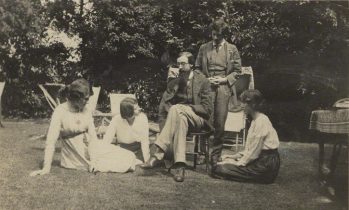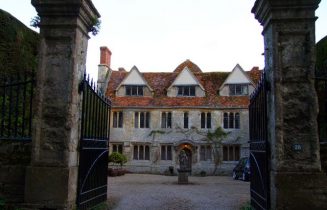Garsington Manor has a long history, having been built in the Middle Ages. Lady Ottoline Morrell and her husband Philip from 1913 to 1928. The couple restored the home during the 20s, creating Italian-style landscaping across the grounds. The Morrells hosted many of their friends over the years at Garsington, including D. H. Lawrence, Siegfried Sassoon, Lytton Strachey, Aldous Huxley, Mark Gertler, and Bertrand Russell; they had many guests during the First World War in particular, when they hosted friends who were conscientious objectors (“Garsington Manor, Oxfordshire, England”).

The friends who spent much of their time at Garsington Manor were not strangers to drama: “It has been described variously as ‘the house of the Ottoline’s,’ a ‘cesspool of slime,’ ‘the setting for a Mozart opera,’ ‘Shandygaff Hall,’ ‘a Boccaccio court,’ ‘a refuge from the storm.’ One thing is

sure: Garsington Manor never lacked either attention or comment during the 14 crowded years it was the home of Lady Ottoline Morrell and her husband, Philip” (Seymour). Lady Ottoline had an affair for years with Bertrand Russell, who lived at Garsington for a period of time – Philip was actually aware of the affair and begrudgingly accepting of it, along with Russell’s spouse as well. Philip had also apparently father two children out of wedlock over the course of one summer. One Christmas in particular got out of hand, much like their other parties:
An incident from Christmas 1914 provided some literary fodder. Katherine, Murry, Koteliansky, the artist Mark Gertler, Lawrence, and Frieda were all staying at Gilbert Cannan’s windmill cottage in Buckinghamshire, when someone suggested putting on an improvised play. Things got out of hand – the gathering was so inebriated that they were unable to carve the Christmas pig – and the play descended towards a bacchanalia, with Katherine flirting outrageously with Gertler. This incident gave Lawrence the episode in Women in Love, where Gudrun goes off with the artist Loerke. (Darroch)
Lawrence was one of multiple authors who wrote about Lady Ottoline, often satirizing her. Lawrence depicted her as Hermione in Women in Love, who he said trated her guests “‘like prisoners marshalled for exercise’” (qtd. in Seymour). “Another (Siegfried Sassoon) paid ungallant homage to Ottoline as an eccentric aristocrat – her height, beaky nose and titian hair would always draw attention – in a satiric account of his hostess wobbling her way down a ladder to greet him in a pair of billowing pink silk bloomers” (Seymour). Aldous Huxley wrote about Ottoline as well in Chrome Yellow. Lady Ottoline was far from fond of these depictions. Her friendships with Lawrence and Huxley were ruined after their writing, particularly Huxley, who was living rent-free at Garsington at the time.

However, despite all of the drama and negative attention put on Lady Ottoline, she and Philip did their best to provide a haven for their friends, especially from the war. They provided farm jobs and living quarters for objectors, and showed great hospitality. The farm work helped with the upkeep and cost of the property, but after the armistice Philip and Lady Ottoline had to sell – the land was getting too expensive. Their legacy with the Bloomsbury group lives on, and is forever a staple of Garsington.
http://www.dhlawrencesocietyaustralia.com.au/lost%20girl/lost%20girl.html
https://www.theguardian.com/books/2014/jul/25/why-garsington-manor-britains-scandalous-retreat
http://www.parksandgardens.org/places-and-people/site/1398/history
https://www.geni.com/projects/Garsington-Manor-Oxfordshire-England/25409



